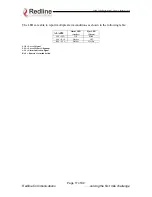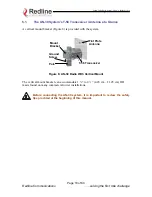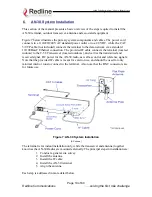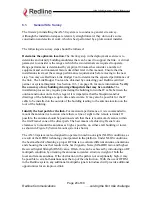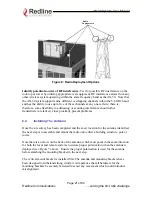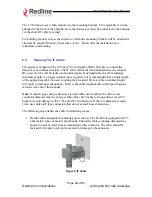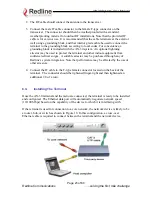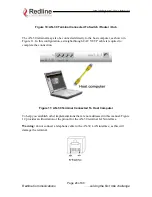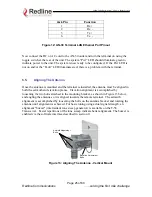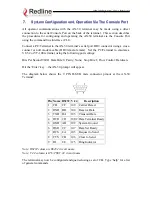
AN-30 System User Manual
6.1.
General Site Survey
The first step in installing the AN-30 system is to conduct a general site survey.
Although the installation steps are relatively straightforward, they do involve some
construction and electrical work, which is best performed by a professional installer.
The following site survey steps should be followed:
Determine the optimum location.
The first key step in the deployment exercise is to
determine and identify building candidates that can be used to support the link. A critical
parameter to consider is the range at which the two terminals are required to operate.
Range performance is determined by empirical formulas that consider a number of
equipment and environmental factors described later in this manual. Ensure that the
installation sites meet these range performance requirements before moving to the next
step. You may use Redline’s Link Budget Tool to determine the expected performance of
the link. The Link Budget Tool can be obtained by contacting your Redline certified
partner or system integrator. See Section 10.3.1 on page 66 for more information.
Verify
the accuracy of any building drawings/blueprints that may be available.
The
installation process may require penetrating the building to run the IF cable between the
outdoor and indoor units. In this regard, it is imperative that the blueprints and/or
drawings of the building are up to date and accurate. It may also be possible for the IF
cable to be installed on the outside of the building leading to the antenna location on the
roof of the building.
Identify the best path for the link.
For maximum performance, it is recommended to
mount the antenna in a location where there is line of sight to the remote terminal. If
possible, the antenna should be positioned such that there is maximum clearance within
the first Fresnel zone of the direct path. The best means of achieving Fresnel zone
clearance is to mount the antennas as high as possible, on either a tall building or tower,
as shown in Figure 8 (Vertical mount system is shown).
The AN-30 system is also designed to operate in non-line-of-sight (NLOS) conditions, as
a result of the OFDM technology incorporated in the platform. Under NLOS conditions,
the best method of obtaining a proper RF link is to evaluate different antenna orientations
and choosing the one that results in the best Signal to Noise (SINADR) ratio and highest
Received Signal Strength (RSSI) value. Often, this can be achieved by introducing an RF
multipath condition by orienting the antennas towards a structure in sight of both the
local and remote antennas. If the obstruction in the path is not exceptionally high, it may
be possible to aim both antennas near the top of the obstruction. With the use of OFDM
in the Redline system, any additional multipath signals introduced will provide additional
opportunities for an improved link.
Page 20 of 80
Redline Communications
…..solving the first mile challenge












